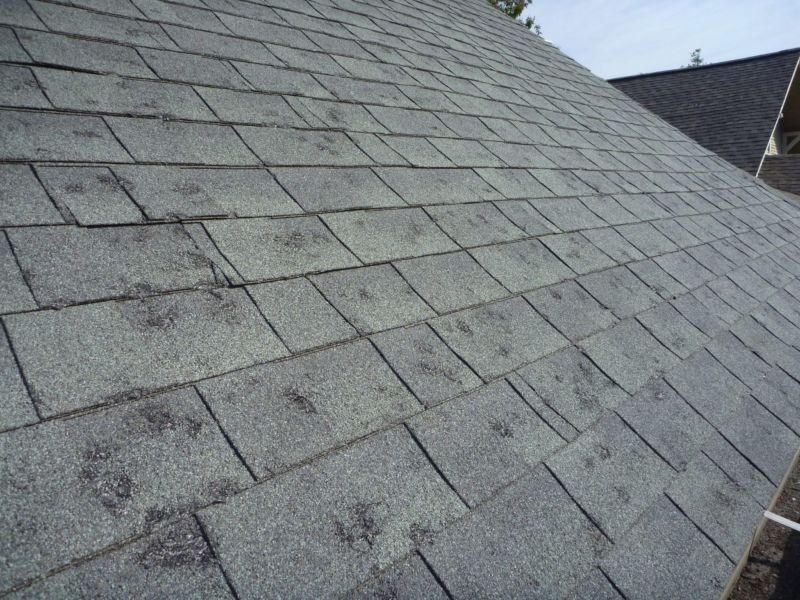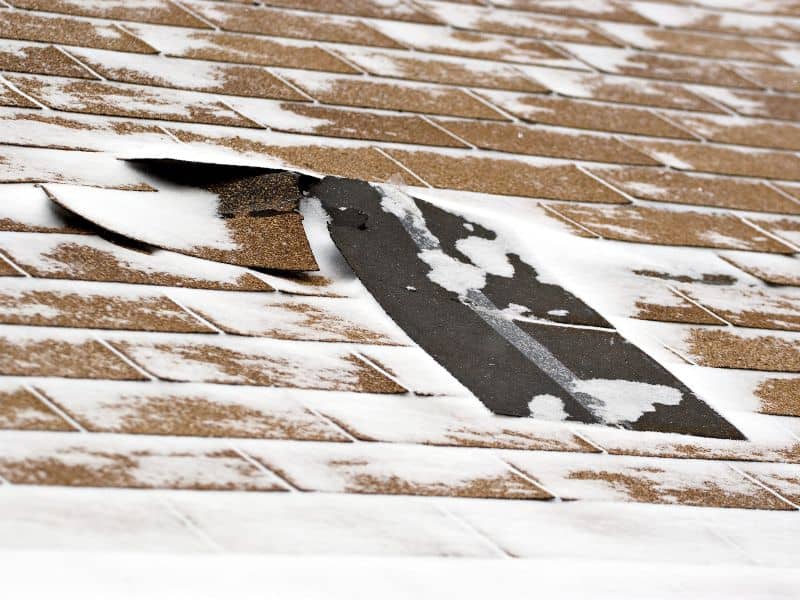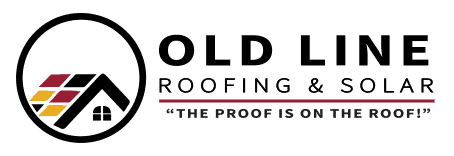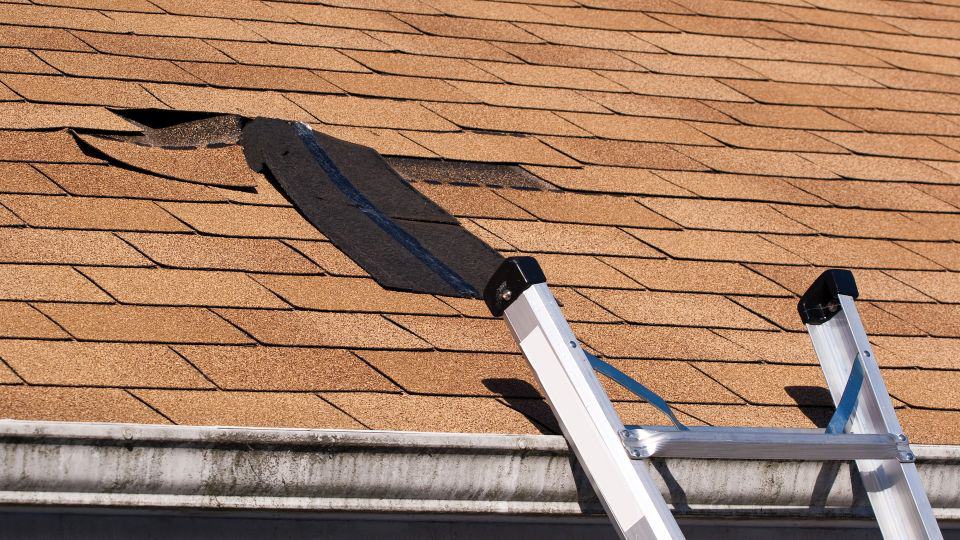Roof damage is a common problem that can lead to costly repairs and even compromise the safety of your home. Identifying and preventing roof damage before it becomes a major issue is crucial for protecting and extending the lifespan of your property and your family. In this blog, we’ll discuss the most common causes of roof damage and the signs to look out for.
Common Causes of Roof Damage
If you suspect that your roof has been damaged by severe weather, it is essential to contact a professional roofing contractor for a roof inspection to assess and repair the damage before it leads to further problems. Early inspection will help prevent roof damage from causing extensive costs.
A. Severe Weather
Wind Damage
Strong winds can uplift shingles, tiles, and metal panels from the roof surface and expose the underlying decking to water damage.
Hail Damage
Hail storms can cause significant damage to your roof surface, especially unprotected shingles, causing cracks, dents, and fractures.
Water Damage
Heavy rainfall and storms can cause water to penetrate the roofing system, saturate the insulation, and create a favorable environment for mold and mildew growth.
Ice and Snow Damage
Ice dams can form on the roof and gutters, leading to water backups and leaks. Snow buildup can also put a lot of weight on the roof structure and cause it to collapse.
Fallen Trees and Debris
Fallen trees and debris can cause significant damage to roofs, especially during severe weather events such as hurricanes and tornadoes. The weight of a fallen tree or large branches can cause structural damage to a roof, including collapsing the roof entirely.
B. Poor Maintenance
C. Age
Over time, exposure to the elements – such as rain, snow, wind, and UV rays – can gradually deteriorate roofing materials. As a roof gets older, it becomes more susceptible to leaks, cracks, warping, and other issues. Additionally, if a roof is not properly maintained or repaired as needed, age-related damage can become more severe. It is generally recommended to have a roof inspected regularly to identify and address any issues and prevent roof damage.

Warning Signs of Roof Damage
Water stains can be caused by many things, but they often indicate water damage or leaks in the roof. If you see water stains on your interior walls or ceilings, it is crucial to address them promptly to prevent roof damage to your home.
A. Loose or missing flashing around chimneys, vents, or skylights
Loose or missing flashing around chimneys, vents, or skylights can lead to water intrusion and damage to the structure and insulation of the building. It is important to have flashing properly installed to prevent water from penetrating the roof system. If the flashing is loose or missing, it should be repaired or replaced as soon as possible to prevent roof damage. It is recommended to hire a professional roofing contractor to assess and repair any flashing issues.
B. Mold or mildew growth on the roof or attic
Homeowners can prevent roof damage by locating mold and mildew growth in the roof or attic by ensuring proper ventilation, sealing any leaks, and maintaining proper insulation. Additionally, it is essential to keep the area clean and dry and not let any water accumulate in the roof or attic space to prevent roof damage. In severe cases, it is recommended to hire a professional to assess the situation and address the issue.
C. Damaged or clogged gutters and downspouts
When gutters are damaged or clogged, water cannot flow away from the building properly. This can cause water to overflow and seep into the foundation, leading to water damage and potential structural issues. The excess water can also cause mold and mildew growth, damage landscaping, and attract pests. Regular maintenance and cleaning of gutters and downspouts can prevent these issues and ensure proper water drainage away from the building and prevent roof damage.
D. Higher than normal energy bills due to poor insulation or ventilation
High energy bills are typically caused by a variety of factors, including poor insulation or ventilation. When a home is not properly insulated or ventilated, it can result in lost heat, drafty areas, and higher energy bills due to the increased use of heating and cooling systems. Additionally, poor insulation and ventilation can lead to moisture buildup, which can cause damage to the home and decrease indoor air quality. To address these issues, it is important to have your home properly insulated and ventilated by a qualified professional. Our professional roofing contractors at Old Line Roofing and Solar are here when you suspect roof damage.
E. Leaks
One of the most common signs of roof damage is a leak. If you notice water stains on your ceiling or walls, it’s likely that your roof has a leak. Leaks can be caused by a variety of factors, such as damaged or missing shingles, cracks in the roof, or faulty flashing. Leaking roofs can cause water damage, mold growth, and rotting. It is necessary to have an inspection of your roof to prevent roof damage and prevent costly repairs.
F. Missing or Damaged Shingles
Missing or damaged shingles are also a sign of roof damage. Shingles can become loose or fall off due to severe weather or age. This can leave your roof vulnerable to water damage and other types of damage. Shingles protect the roof from rain, sun, and other weather elements, and when they are missing or damaged, the roof is exposed to potential leaks and deterioration. Proper repair can further prevent roof damage.
G. Sagging or Uneven Sections
Sagging or uneven sections of your roof can also be a sign of damage. This can be caused by weakened or damaged roof supports, water damage, or other factors. If you notice any sagging or uneven sections, it’s important to call a professional for a thorough inspection. Sagging or uneven sections of your roof can indeed be a sign of damage. This could be due to issues with the roof decking, such as water damage or decay, or areas where the roof has weakened and is no longer able to support the weight of the roofing materials. If you notice sagging or uneven sections of your roof, it’s important to have it inspected by a professional roofing contractor as soon as possible to determine the extent of the damage and address any necessary repairs or replacements. Neglecting to address these issues could lead to more significant and costly damage in the future, as well as potential safety hazards.
Preventing Roof Damage
Preventing roof damage is key to protecting your home and avoiding costly repairs. Regular maintenance, such as cleaning gutters and downspouts, trimming overhanging branches, and removing debris from the roof, can help prevent damage. It’s also important to have a roof inspection regularly by a professional to identify any potential issues before they become major problems. Contact our specialists at Old Line Roofing and Solar if you spot signs of roof damage.

Preventative Measures to Prevent Roof Damage
A. Regular Maintenance to prevent roof damage
One of the most important things you can do to prevent roof damage is to keep up with regular maintenance. This includes checking for any signs of damage or wear and tear, such as cracked or missing shingles, and making any necessary repairs as soon as possible. Regular maintenance can also help you identify potential problems before they become major issues.
B. Cleaning Gutters
Another key preventative measure is to clean your gutters regularly. Clogged gutters can cause water to back up and damage your roof, so it’s important to keep them clear of debris. Make sure to check them at least twice a year, and more often if you live in an area with a lot of trees.
C. Trimming Trees
Trees can be beautiful, but they can also pose a threat to your roof if they’re too close. Make sure to trim any branches that are hanging over your roof or touching it. This will prevent them from rubbing against your roof and causing damage.
D. Upgrading Insulation to prevent roof damage
If your home is poorly insulated, it can cause your roof to deteriorate more quickly. Upgrading your insulation can help keep your roof in good condition by preventing heat from escaping and causing damage.
Repairing Roof Damage
Even with preventative measures in place, accidents can still happen, and you may find yourself facing roof damage. Here are the steps you should take to repair any damage:
A. Identify the Problem
The first step in repairing roof damage is to identify the problem. This may include inspecting your roof for any leaks, missing shingles, or other signs of damage.
B. Hire a Contractor
Once you’ve identified the problem, it’s time to hire a contractor to repair the damage. Make sure to do your research and find a reputable contractor who has experience with roof repair.
C. Complete the Repair Work
Once your contractor has identified the problem and come up with a plan to repair it, they will begin the repair work. This may include replacing damaged shingles, patching leaks, or even replacing the entire roof if necessary and to further prevent roof damage.
Conclusion
Preventing roof damage is crucial for homeowners who want to avoid costly repairs and keep their homes safe. By following the preventative measures outlined in this blog post, you can help keep your roof in good condition and prevent damage from occurring. And if you do find yourself facing roof damage, don’t panic – just follow the steps outlined above to get your roof back in good shape. Remember, early identification and prevention is key to avoiding potential safety hazards and costly repairs in the future.
Contact Us!
Our roofing company at Old Line Roofing and Solar are here if you need us to inspect your roof for damage or any other roofing issues. Contact us for a free quote today!

